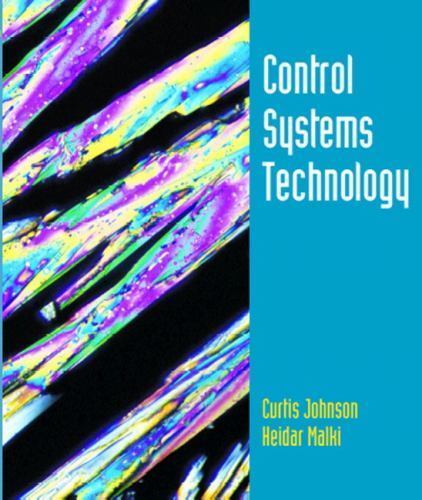Imagen 1 de 1

Foto genérica

Imagen 1 de 1

Foto genérica

Control Systems Technology by Hal Johnson, Heidar Malki and Curtis D. Johnson (2019, Trade Paperback)

rofor_1657 (80)
100% de votos positivos
Precio:
USD124,80
Aproximadamente106,64 EUR
+ USD36,18 de envío
Devoluciones:
30 días para devoluciones. El comprador paga el envío de la devolución..
Estado:
This book is hard cover no damages but tiny bit of pencil marks on it.
Oops! Looks like we're having trouble connecting to our server.
Refresh your browser window to try again.
Acerca de este artículo
Product Identifiers
PublisherPrentice Hall PTR
ISBN-100130815306
ISBN-139780130815309
eBay Product ID (ePID)1860978
Product Key Features
Number of Pages488 Pages
Publication NameControl Systems Technology
LanguageEnglish
SubjectMechanics / Dynamics, Electronics / General
Publication Year2019
TypeTextbook
Subject AreaTechnology & Engineering, Science
AuthorHal Johnson, Heidar Malki, Curtis D. Johnson
FormatTrade Paperback
Dimensions
Item Height1 in
Item Weight30.7 Oz
Item Length9.1 in
Item Width7.3 in
Additional Product Features
Intended AudienceCollege Audience
LCCN2001-023487
Dewey Edition21
IllustratedYes
Dewey Decimal629.8
Table Of Content(NOTE: Each chapter begins with Purpose and concludes with Summary and Problems. ) 1. Introduction to Control Systems. Introduction. Analytical Descriptions. Analog and Digital Control. System Design Objectives. 2. Measurement. Measurement Principles. Sensors. 3. Laplace Transforms. Introduction. Definition of the Laplace Transform. Properties of Laplace Transforms. Inverse Laplace Transform. Analog Simulation. 4. Control System Models. Transfer Functions. Block Diagrams. Mason's Gain Formula. Controller/Compensator Transfer Functions. 5. Static and Dynamic Response. Static Response. Dynamic Response of 1st and 2nd Order Plants. Characteristics of Dynamic Response. Relation to Stability. 6. Stability. Definitions of Stability. Routh Stability Criterion. 7. Frequency Response Analysis. Basic Principles. Control System Bode Plots. Bode Plot Applications. 8. Root Locus. Introduction to Root Locus. Root Locus Construction. Root Locus Applications. 9. State Space Analysis. State Space Definition. Solving State Space Equations. Simulation Diagrams and State Space Equations. Transfer Function in State Space. Controllability and Observability. 10. Introduction to Digital Control Systems. Definition of a Digital Control System. The Difference Equation. 11. Z-Transform and the Difference Equation. Definition of the z-Transform. Properties of z-Transforms. Inverse z-Transform. Difference Equation Solution. 12. Discrete Control Systems. Sampled Plant z-Transform. Open Loop Transfer Functions. Closed Loop Transfer Functions. Static and Dynamic Response. 13. Stability of Discrete Control Systems. Conditions for Stability. Stability Tests. Discrete System Root Locus. 14. Discrete State Space. State Space Equations in the Discrete Domain. Discrete State Space Transfer Function. Observability and Controllability. Discrete Simulation Diagrams. Appendices. Odd Problem Solutions. Index.
SynopsisThis book presents All of the major topics in modern analog and digital control systems, along with the practical, applications oriented knowledge and skills needed by technicians. It contains user-friendly conceptual explanations and clearly written mathematical developments. Examples of both Mathcad and MATLAB illustrate computer problem solving--but this book emphasizes the ability to use any suitable software to achieve successful results in solving problems and performing design. Chapter topics include Measurement; Laplace Transforms; Control System Models; Static and Dynamic Response; Stability; Frequency Response Analysis; Root Locus; State Variable Analysis; Introduction to Discrete Control Systems; Z-Transforms and Discrete State-Space Analysis; Digital Signal Representations; Discrete Time Control Systems; Stability of Discrete Control Systems; and Advanced Topics in Control Systems. For engineers and technicians working for companies that integrate control systems with the use of programmable logic controllers., For two-semester, junior/senior-level courses in Industrial Electronics, Control Systems, Analog and Digital Control Systems, and Applied Control Systems. Thorough in topic coverage, and modern in the emphasis on computers as a problem solving tool, this text presents a comprehensive treatment of analog and digital control systems, with readable conceptual explanations and clearly written mathematical developments. Its computer-solving approach uses examples of both Mathcad and MATLAB but stresses the ability to use any suitable software to achieve successful results in solving problems and performing design.
LC Classification NumberTS156.8.J627 2002




